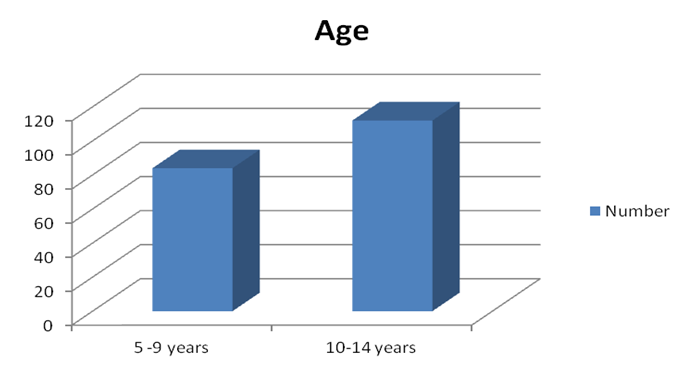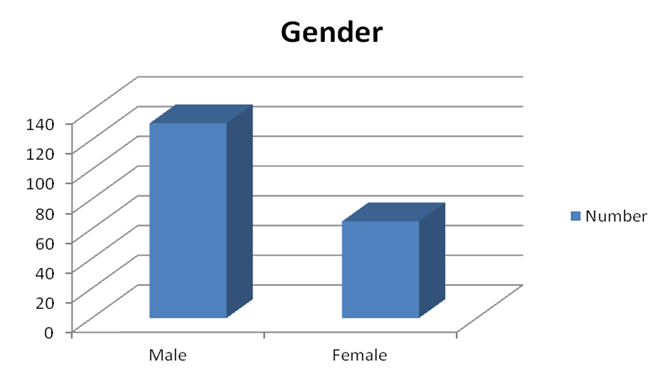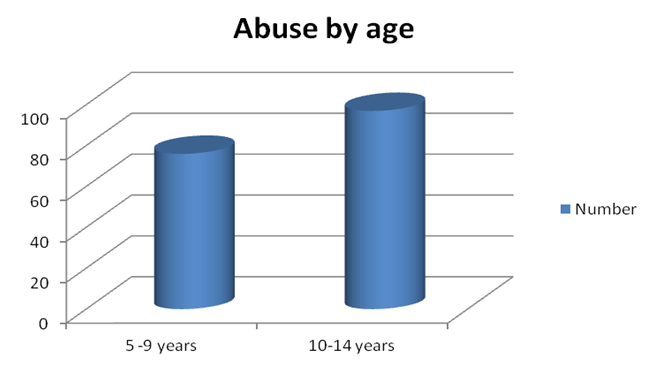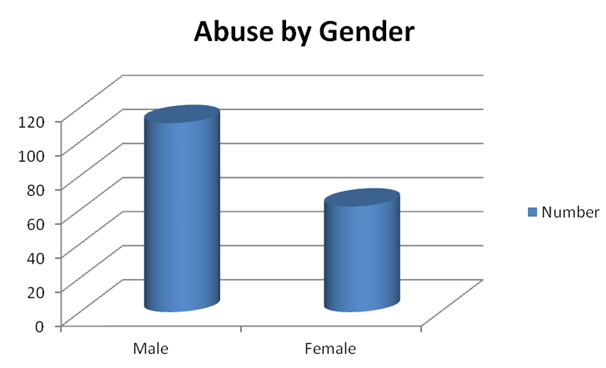Abstract
Objective: To assess and find the prevalence of
abuse in autistic children and find solutions.
Methods: An epidemiological study was conducted using a psychiatric
interview based on the DSM-V to assess symptoms of autism in children 5-14
years old. The interview was conducted with all children who had been referred
to a psychiatric clinic from pediatric, psychosocial, and family medicine
clinics because of abnormal psychological behavior, including signs of abuse,
and data were collected between December 24, 2016, and December 27, 2017.
Results: In total, 196 children (131 male’s (66.84%) and 65 female’s
(33.16%)) were referred to the psychiatry clinic with abnormal behavior or
signs of abuse. They were divided into two major groups: Group 1 (5-9 years)
included 84 children (42.86%), and Group 2 (10-14 years) included 112 children
(57.14%). Abuse was reported among 173 (88.27%) of the referred children,
consisting of 76 (43.93%) in Group 1, and 97 (56.07%) in Group 2; 64.16% were
males and 35.84% were females. Of the autistic children, 80 (46.2%) were found
to have physical signs of abuse, and of these: 52 (75%) were found to have
emotional disturbance; 36 were males (69.23%).
Forty-two (80.77%) of these children were 5-9 years old.
Conclusion: Abuse
is common in children with autism and occurs in many forms. Clinicians need an
understanding of the nature of abuse and mitigation strategies. Basic
strategies for assessment and management are needed in guideline protocols,
which need to be informed by the challenges encountered by autistic individuals
and their caregivers.
Key words: Abuse, autism spectrum disorder, children with
autism, repetitive movement
JRMS December 2019;26(3):84-91 :10.12816/0054823
Introduction:
Autism is a developmental disorder that appears in early childhood, causing delays in many basic areas of development, such as learning to talk and interact with others.
Recent reports estimate the prevalence of autism or autism spectrum disorder to be as high as 1:68.(1, 5) Autism symptoms vary widely as do the effects of this disorder. Children with autism usually have problems in the following three areas, which begin during the first 36 months of a child's life: (1, 2, 9) Intervention and treatment is the earlier the better. (3, 5)
1) Social Skills: impaired social
interaction is the hallmark sign of autism. This may manifest as a marked lack
of interest in other people and the environment. Children with autism often
appear to be in their own small world. They have problems engaging in
interactive play, sharing emotions, making friends, and understanding what
others are thinking and feeling.
2) Communication: autism also includes
problems in verbal and nonverbal communication, including delayed speech, or
lack thereof. Even when autistic children are able to speak, they often have
trouble expressing themselves. Other common symptoms include individual or repetitive
speech patterns, inappropriate facial expressions, gestures, and difficulty in
understanding language
3) Repetitive behavior: autistic
children often exhibit repetitive or "stereotyped" behaviors and
narrow, restricted interests. This may manifest as a severe resistance to
change, obsessive attachments to unusual objects, or inflexible routines and
schedules. Frequent restricted / repetitive body and motor movements, or
self-alert behaviors, such as hand fluttering, flapping and / or difficulty
coping with change are also common.
Although
the causes of autism are not fully understood yet, conventional wisdom
regarding difference in the outcome of the disorder, so it’s important to know
autism’s warning signs. (4, 6)
Categories of abuse include physical
abuse, physical neglect, emotional abuse, and sexual abuse. (7, 8)
In addition to the previous
categories of abuse, I would add over-protection and over-caring, which I would
call “invisible abuse” because in the future, when these autistic children no longer
have caregivers, they will have developed a dependent personality in addition
to their disability and mostly autistic children have low IQ.
The social isolation and poor
communication skills of children with autistic spectrum disorders (ASD) put
them at a particularly high risk of abuse. Often, children who are autistic are
targeted for abuse because of their disability, because perpetrators see them
as vulnerable children who are easy to lure and exploit,they also show it in
ways that are ignored or misused to autism rather than potential abuse,
repetitive body movements "of their own, or self-alert behaviors” making
them odd. (8, 10)
Because of these recognized issues,
there must be reliable and effective ways to determine whether a child with
autism spectrum disorder has been abused or not. These protocols should be
based on the challenges faced by individuals with autism and associated
symptoms, as expressed by those who live on the spectrum, as well as by
researchers of autism. In addition, we need to educate caregivers on the notion
that over-protection and over-caring could also be abuse-like in that it can
render those on the autism spectrum overly dependent in later life.
Methods
An epidemiological study was conducted using a psychiatric
interview based on the diagnostic and Statistical
Manual - Fifth Edition (DSM V),children diagnosed as a case of autistic spectrum disorder,
were asked to participate in this study through their caregivers to assess
symptoms of abuse in children with autism. A total of 196 child 5-14 years old
was assessed. The interview was conducted on all children who had been referred
to a psychiatric clinic from pediatric, psychosocial, and family medicine
clinics because of abnormal psychological behavior which might related to
emotional abuse and signs on their body's, including signs of abuse, data were
collected during one year period"between 24 December 2016 and 27December
2017".
Results
In total, 196 children were referred to the psychiatry
clinic with abnormal behavior or signs of abuse. Children were divided into two
major groups: Group 1 (5-9 years) included 84 children (42.86%), and Group 2
(10-14 years) included 112 children (57.14%). See [table I] and [Figure 1].
Table
I:Distribution of referred children by age.
|
Age
|
Number
|
Percentage
|
|
5 -9 years
|
84
|
42.86%
|
|
10-14 years
|
112
|
57.14%
|
|
Total
|
196
|
100%
|

Figure 1: Distribution of referred children by age.
Study subjects comprised 131 males (66.84%)
and 65 females (33.16%). See [table II], [Figure 2], and[Table VI].
Table II:Distribution
of referred children by gender
|
Gender
|
Number
|
Percentage
|
|
Male
|
131
|
66.84%
|
|
Female
|
65
|
33.16%
|
|
Total
|
196
|
100%
|
Table VI: Children
with autism aged 5 to 14 years referred then found to have any form of abuse,
comparison between genders
|
Autism-By age
|
Male
|
Female
|
Male as % of total
|
Female as % of total
|
|
5 years
|
7
|
4
|
4.05%
|
2.31%
|
|
6 years
|
8
|
5
|
4.62%
|
2.89%
|
|
7 years
|
12
|
9
|
6.94%
|
5.20%
|
|
8 years
|
9
|
3
|
5.20%
|
1.73%
|
|
9 years
|
12
|
7
|
6.94%
|
4.05%
|
|
10 years
|
11
|
5
|
6.36%
|
2.89%
|
|
11 years
|
11
|
6
|
6.36%
|
3.47%
|
|
12 years
|
16
|
9
|
9.25%
|
5.20%
|
|
13 years
|
12
|
6
|
6.94%
|
3.47%
|
|
14 years
|
13
|
8
|
7.51%
|
4.62%
|
|
Total
|
111
|
62
|
64.16%
|
35.84%
|

Figure
2:Distribution of referred children by gender.
Abuse
was found in 173 (88.27%) of the referred children, consisting of 76 (43.93%)
in Group 1, and 97 (56.07%) in Group 2. see [Table III] and [Figure 3].
Table III:Distribution
of children with autism by age
|
Age
|
Number
|
Percentage
|
|
5 -9 years
|
76
|
43.93%
|
|
10-14 years
|
97
|
56.07%
|
|
Total
|
173
|
100%
|

Figure 3:Distribution
of children with autism by age.
64.16% were males, and 35.84% were females.
see [Table IV] and [Figure 4]. Of the autistic children, 80 (46.2%) were found
to have physical signs of abuse, and out of these, 52 (75%) were found to have
an emotional disturbance; 36 were males (69.23%).42 (80.77%) of these children
were 5-9 years old. see [Table V].
Table IV:
Distribution of children with autism by gender
|
Gender
|
Number
|
Percentage
|
|
Male
|
111
|
64.16%
|
|
Female
|
62
|
35.84%
|
|
Total
|
173
|
100%
|
Table
V:Distribution of emotional disturbance by age and gender
|
Age in years
|
Male
|
Female
|
Total
|
|
5-9
|
32
|
10
|
42
|
|
10-14
|
4
|
6
|
10
|
|
Total
|
36
|
16
|
52
|

Figure 4:Distribution
of abused children by gender
Discussion
All
referred cases with signs of abuse in the psychiatry clinic were believed to
have no organic cause or signs related to their disorder that had been excluded
by the referring clinic. Many of the parents of children with autism spectrum
disorder were not aware that their child’s abuse was related to the
characteristics of autism and their over-protection. This study showed that
(ASD) was found to be the most common mental disorder among victims of abuse. (3)
In our study, boys reported significantly higher figures than girls
(69.23% versus 30.77%). We also found a higher prevalence among children 5-9
year old (80.77%).
Conclusion
Abuse
is common in children with autism and occurs in many forms. All clinicians need
an understanding of the nature of abuse and mitigation strategies. Basic
strategies for assessment and management are needed in guideline protocols,
which need to be informed by the challenges encountered by autistic individuals
and their caregivers. Forensic interviews were employed to determine whether or
not abuse had occurred; some of these included cognitive interviews,
anatomically detailed, and structured interviews. (10)
Additionally, we need to be the voice of these abused children and advocate for
them in the government and legislative bodies to build a protective and strict
limit system to prevent the abuse of children with autism and develop a system
to train their parents and caregivers to care for them effectively in an
optimized way that avoids over-protection.
References
1. Diagnostic and Statistical Manual of
Mental Disorders, Fifth
Edition, American Psychiatric Association, Arlington, VA. (2013).
2. Kaplan and Sadock's Synopsis of Psychiatry: Behavioral Sciences/Clinical Psychiatry Eleventh Edition. By Benjamin J. Sadock (Author), Virginia A. Sadock (Author), Dr. Pedro Ruiz MD (Author)
3. Maltreatment and disabilities: a population-based epidemiological study by Sullivan PM1, Knutson JF. Boys Town National Research Hospital, Omaha, NE 68131, USA.
4. Handbook for pediatric psychology fourth edition 2009, Editors Michael C. Roberts Ric G. Steele. Centers for Disease Control and Prevention (2014). Autism information center.http://www.cdc.gov/ncbddd/autism/faq_prevalence.htm#whatisprevalence.
5. Fombonne, E.: Epidemiological
surveys of autism and other pervasive developmental disorders: an update. J. Autism Dev.
Disorder. (2003).
6. Risk of maltreatment for children
with Autism spectrum disorder. Virginia Child Protection Newsletter. Spring, 2013.
7. Chaffin, M. (2004). Is it time to rethink Healthy Start/Healthy Families? Child Abuse and Neglect.
8.
Lord C, Rutter M. Autism and pervasive
developmental disorders. In: Taylor E, Hersov L, eds. Child and adult
psychiatry. Modern approaches. Oxford: Blackwell Science, 1994.
9.
Disability Studies Quarterly. Winter 2010, Vol. 30 Issue 1,
p.16. Edelson, Meredyth Goldberg Edelson, Willamette University, Department of
Psychology, 900 State Street, Salem, OR 97301.
10. Disability
Studies Quarterly .
Winter2010, Vol. 30 Issue 1, p16-16. 1p.
Edelson, Meredyth GoldbergEdelson, Willamette University, Department of
Psychology, 900 State Street, Salem, OR 97301, E-mail: medelson@willamette.edu